Barack Obama
Barack Hussein Obama II ( born August 4, 1961) is an American politician who served as the 44th
President of the United States from 2009 to 2017. He is the first African American to have served as president. He previously served in the U.S. Senate representing Illinois from 2005 to 2008 and in the Illinois State Senate from 1997 to 2004.
Obama was born in Honolulu, Hawaii, two years after the territory was admitted to the Union as the 50th state. Raised largely in Hawaii, Obama also spent one year of his childhood in Washington State and four years in Indonesia. After graduating from Columbia University in 1983, he worked as a community organizer in Chicago. In 1988 Obama enrolled in Harvard Law School, where he was the first black president of the Harvard Law Review. After graduation, he became a civil rights attorney and professor, teaching constitutional law at the University of Chicago Law School from 1992 to 2004. Obama represented the 13th District for three terms in the Illinois Senate from 1997 to 2004, when he ran for the U.S. Senate. Obama received national attention in 2004, with his unexpected March primary win, his well-received July Democratic National Convention keynote address, and his landslide November election to the Senate. In 2008, Obama was nominated for president, a year after his campaign began, and after a close primary campaign against Hillary Clinton. He was elected over Republican John McCain, and was inaugurated on January 20, 2009. Nine months later, Obama was named the 2009 Nobel Peace Prize laureate.
During his first two years in office, Obama signed many landmark bills. Main reforms were the Patient Protection and Affordable Care Act (often referred to as "Obamacare"), the Dodd–Frank Wall Street Reform and Consumer Protection Act, and the Don't Ask, Don't Tell Repeal Act of 2010. The American Recovery and Reinvestment Act of 2009 and Tax Relief, Unemployment Insurance Reauthorization, and Job Creation Act of 2010 served as economic stimulus amidst the Great Recession, but the GOP regained control of the House of Representatives in 2011. After a lengthy debate over the national debt limit, Obama signed the Budget Control and the American Taxpayer Relief Acts. In foreign policy, Obama increased U.S. troop levels in Afghanistan, reduced nuclear weapons with the U.S.-Russian New START treaty, and ended military involvement in the Iraq War. He ordered military involvement in Libya in opposition to Muammar Gaddafi, and the military operation that resulted in the death of Osama bin Laden.
After winning re-election by defeating Republican nominee Mitt Romney, Obama was sworn in for a second term in 2013. During his second term, Obama promoted greater inclusiveness for LGBT Americans, with his administration filing briefs that urged the Supreme Court to strike down same-sex marriage bans as unconstitutional (United States v. Windsor and Obergefell v. Hodges). Obama also advocated gun control in response to the Sandy Hook Elementary School shooting, and issued wide-ranging executive actions concerning climate change and immigration. In foreign policy, Obama ordered military intervention in Iraq in response to gains made by ISIL after the 2011 withdrawal from Iraq, continued the process of ending U.S. combat operations in Afghanistan, promoted discussions that led to the 2015 Paris Agreement on global climate change, initiated the sanctions against Russia following the invasion in Ukraine, brokered a nuclear deal with Iran, and normalized U.S. relations with Cuba.
Obama left office in January 2017 with a 60% approval rating.[3][4] He currently resides in Washington, D.C. His presidential library will be built in Chicago.
Early life and career
Obama was born on August 4, 1961,[5] at Kapiʻolani Maternity & Gynecological Hospital in Honolulu, Hawaii.[6][7][8] He is the first President to have been born in Hawaii,[9] making him the first President born outside of the contiguous "lower 48" states.[10] He was born to a white mother and a black father. His mother, Ann Dunham (1942–1995), was born in Wichita, Kansas, of mostly English descent,[11] with some German, Irish, Scottish, Swiss, and Welsh ancestry.[12] His father, Barack Obama Sr. (1936–1982), was a married Luo Kenyan man from Nyang'oma Kogelo. Obama's parents met in 1960 in a Russian language class at the University of Hawaii at Manoa, where his father was a foreign student on scholarship.[13][14] The couple married in Wailuku, Hawaii on February 2, 1961, six months before Obama was born.[15][16]In late August 1961, Obama's mother moved with him to the University of Washington in Seattle for a year. During that time, Obama Sr. completed his undergraduate degree in economics in Hawaii in June 1962, then left to attend graduate school on a scholarship at Harvard University, where he earned an M.A. in economics. Obama's parents divorced in March 1964.[17] Obama Sr. returned to Kenya in 1964, where he married for a third time. He visited his son in Hawaii only once, in 1971,[18] before he was killed in an automobile accident in 1982, when Obama was 21 years old.[19] Of his early childhood, Obama recalled, "That my father looked nothing like the people around me – that he was black as pitch, my mother white as milk – barely registered in my mind."[14] He described his struggles as a young adult to reconcile social perceptions of his multiracial heritage.[20]
In 1963, Dunham met Lolo Soetoro, an Indonesian East–West Center graduate student in geography at the University of Hawaii, and the couple were married on Molokai on March 15, 1965.[21] After two one-year extensions of his J-1 visa, Lolo returned to Indonesia in 1966, followed sixteen months later by his wife and stepson in 1967, with the family initially living in a Menteng Dalam neighborhood in the Tebet subdistrict of south Jakarta, then from 1970 in a wealthier neighborhood in the Menteng subdistrict of central Jakarta.[22]
Education
From age six to ten, Obama attended local Indonesian-language schools: Santo Fransiskus Asisi (St. Francis of Assisi) Catholic School for two years and Besuki Public School for one and a half years, supplemented by English-language Calvert School homeschooling by his mother.[23][24] During his time in Indonesia, Obama's step-father taught him to be resilient and gave him "a pretty hardheaded assessment of how the world works".[25]Obama returned to Honolulu in 1971 to live with his maternal grandparents, Madelyn and Stanley Dunham. He attended Punahou School— a private college preparatory school— with the aid of a scholarship from fifth grade until his graduation from high school in 1979.[26] In his youth, Obama went by the nickname "Barry".[27] Obama lived with his mother and sister in Hawaii for three years from 1972 to 1975 while his mother was a graduate student in anthropology at the University of Hawaii.[28] Obama chose to stay in Hawaii with his grandparents for high school at Punahou when his mother and sister returned to Indonesia in 1975 so his mother could begin anthropology field work.[29] His mother spent most of the next two decades in Indonesia, divorcing Lolo in 1980 and earning a PhD degree in 1992, before dying in 1995 in Hawaii following unsuccessful treatment for ovarian cancer and uterine cancer.[30]
Reflecting later on his years in Honolulu, Obama wrote: "The opportunity that Hawaii offered – to experience a variety of cultures in a climate of mutual respect – became an integral part of my world view, and a basis for the values that I hold most dear."[31] Obama has also written and talked about using alcohol, marijuana, and cocaine during his teenage years to "push questions of who I was out of my mind".[32] Obama was also a member of the "choom gang", a self-named group of friends that spent time together and occasionally smoked marijuana.[33][34]
After graduating from high school in 1979, Obama moved to Los Angeles to attend Occidental College. In February 1981, Obama made his first public speech, calling for Occidental to participate in the disinvestment from South Africa in response to that nation's policy of apartheid.[35] In mid-1981, Obama traveled to Indonesia to visit his mother and half-sister Maya, and visited the families of college friends in Pakistan and India for three weeks.[35] Later in 1981, he transferred as a junior to Columbia University in New York City, where he majored in political science with a specialty in international relations[36] and in English literature[37] and lived off-campus on West 109th Street.[38] He graduated with a BA degree in 1983 and worked for about a year year at the Business International Corporation, where he was a financial researcher and writer,[39][40] then at the New York Public Interest Research Group.[41][42] In 1985, Obama was among the leaders of May Day efforts to bring attention to the New York City Subway system, which was in a bad condition at the time. Obama traveled to several subway stations to get people to sign letters addressed to local officials and the Metropolitan Transportation Authority, and was photographed at the City College subway station holding a sign protesting against the system's condition.
Family and personal life
Obama posing in the Green Room of the White House with wife Michelle and daughters Sasha and Malia in 2009
Obama taking a left-handed jump shot during a pick-up game on the White House basketball court, 2009
Obama lived with anthropologist Sheila Miyoshi Jager while he was a community organizer in Chicago in the 1980s.[58] He proposed to her twice, but both Jager and her parents turned him down.[58][59] The relationship was only made public in May 2017, several months after Obama's two-term presidency had ended.[59]
Obama and his wife Michelle at the Civil Rights Summit at the LBJ Presidential Library in 2014
Applying the proceeds of a book deal, the family moved in 2005 from a Hyde Park, Chicago condominium to a $1.6 million house in neighboring Kenwood, Chicago.[68] The purchase of an adjacent lot—and sale of part of it to Obama by the wife of developer, campaign donor and friend Tony Rezko—attracted media attention because of Rezko's subsequent indictment and conviction on political corruption charges that were unrelated to Obama.[69]
In December 2007, Money estimated the Obama family's net worth at $1.3 million.[70] Their 2009 tax return showed a household income of $5.5 million—up from about $4.2 million in 2007 and $1.6 million in 2005—mostly from sales of his books.[71][72] On his 2010 income of $1.7 million, he gave 14% to non-profit organizations, including $131,000 to Fisher House Foundation, a charity assisting wounded veterans' families, allowing them to reside near where the veteran is receiving medical treatments.[73][74] As per his 2012 financial disclosure, Obama may be worth as much as $10 million.[75]
In reference to Obama's smoking habit, Michelle said in early 2010 that he had quit smoking.[76][77]
On his 55th birthday, August 4, 2016, Obama penned an essay in Glamour describing how his daughters and being president have made him a feminist.[78][79][80]
Religious views
The Obamas worship at African Methodist Episcopal Church in Washington, D.C., January 2013
In January 2008, Obama told Christianity Today: "I am a Christian, and I am a devout Christian. I believe in the redemptive death and resurrection of Jesus Christ. I believe that faith gives me a path to be cleansed of sin and have eternal life."[83] On September 27, 2010, Obama released a statement commenting on his religious views saying "I'm a Christian by choice. My family didn't – frankly, they weren't folks who went to church every week. And my mother was one of the most spiritual people I knew, but she didn't raise me in the church. So I came to my Christian faith later in life, and it was because the precepts of Jesus Christ spoke to me in terms of the kind of life that I would want to lead – being my brothers' and sisters' keeper, treating others as they would treat me."[84][85]
Obama met Trinity United Church of Christ pastor Rev. Jeremiah Wright in October 1987, and became a member of Trinity in 1992.[86] He resigned from Trinity in May 2008 during his first presidential campaign after some of Wright's statements were criticized.[87] The Obama family has attended several Protestant churches since moving to Washington, D.C., in 2009, including Shiloh Baptist Church and St. John's Episcopal Church, as well as Evergreen Chapel at Camp David, but are not habitual church-goers.
Law career
Community organizer and Harvard Law School
Two years after graduating from Columbia, Obama was hired in Chicago as director of the Developing Communities Project, a church-based community organization originally comprising eight Catholic parishes in Roseland, West Pullman, and Riverdale on Chicago's South Side. He worked there as a community organizer from June 1985 to May 1988.[42][91] He helped set up a job training program, a college preparatory tutoring program, and a tenants' rights organization in Altgeld Gardens.[92] Obama also worked as a consultant and instructor for the Gamaliel Foundation, a community organizing institute.[93] In mid-1988, he traveled for the first time in Europe for three weeks and then for five weeks in Kenya, where he met many of his paternal relatives for the first time.[94][95]Chicago Law School and civil rights attorney
In 1991, Obama accepted a two-year position as Visiting Law and Government Fellow at the University of Chicago Law School to work on his first book.[103][104] He then taught constitutional law at the University of Chicago Law School for twelve years, first as a Lecturer from 1992 to 1996, and then as a Senior Lecturer from 1996 to 2004.[105]From April to October 1992, Obama directed Illinois's Project Vote, a voter registration campaign with ten staffers and seven hundred volunteer registrars; it achieved its goal of registering 150,000 of 400,000 unregistered African Americans in the state, leading Crain's Chicago Business to name Obama to its 1993 list of "40 under Forty" powers to be.[106]
He joined Davis, Miner, Barnhill & Galland, a 13-attorney law firm specializing in civil rights litigation and neighborhood economic development, where he was an associate for three years from 1993 to 1996, then of counsel from 1996 to 2004. In 1994, he was listed as one of the lawyers in Buycks-Roberson v. Citibank Fed. Sav. Bank, 94 C 4094 (N.D. Ill.).[107] This class action lawsuit was filed in 1994 with Selma Buycks-Roberson as lead plaintiff and alleged that Citibank Federal Savings Bank had engaged in practices forbidden under the Equal Credit Opportunity Act and the Fair Housing Act.[108] The case was settled out of court.[109] Final Judgment was issued on May 13, 1998, with Citibank Federal Savings Bank agreeing to pay attorney fees.[110] His law license became inactive in 2007.[111][112]
From 1994 to 2002, Obama served on the boards of directors of the Woods Fund of Chicago, which in 1985 had been the first foundation to fund the Developing Communities Project, and of the Joyce Foundation.[42] He served on the board of directors of the Chicago Annenberg Challenge from 1995 to 2002, as founding president and chairman of the board of directors from 1995 to 1999.[42]
Legislative career
Illinois State Senator (1997–2004)
State Senator Obama and others celebrate the naming of a street in Chicago after ShoreBank co-founder Milton Davis in 1998
He was reelected to the Illinois Senate in 1998, defeating Republican Yesse Yehudah in the general election, and was reelected again in 2002.[117] In 2000, he lost a Democratic primary race for Illinois's 1st congressional district in the United States House of Representatives to four-term incumbent Bobby Rush by a margin of two to one.[118]
In January 2003, Obama became chairman of the Illinois Senate's Health and Human Services Committee when Democrats, after a decade in the minority, regained a majority.[119] He sponsored and led unanimous, bipartisan passage of legislation to monitor racial profiling by requiring police to record the race of drivers they detained, and legislation making Illinois the first state to mandate videotaping of homicide interrogations.[115][120] During his 2004 general election campaign for the U.S. Senate, police representatives credited Obama for his active engagement with police organizations in enacting death penalty reforms.[121] Obama resigned from the Illinois Senate in November 2004 following his election to the U.S. Senate.[122]
2004 U.S. Senate campaign
Obama was an early opponent of the George W. Bush administration's 2003 invasion of Iraq.[124] On October 2, 2002, the day President Bush and Congress agreed on the joint resolution authorizing the Iraq War,[125] Obama addressed the first high-profile Chicago anti-Iraq War rally,[126] and spoke out against the war.[127] He addressed another anti-war rally in March 2003 and told the crowd that "it's not too late" to stop the war.[128]
Decisions by Republican incumbent Peter Fitzgerald and his Democratic predecessor Carol Moseley Braun to not participate in the election resulted in wide-open Democratic and Republican primary contests involving fifteen candidates.[129] In the March 2004 primary election, Obama won in an unexpected landslide—which overnight made him a rising star within the national Democratic Party, started speculation about a presidential future, and led to the reissue of his memoir, Dreams from My Father.[130] In July 2004, Obama delivered the keynote address at the 2004 Democratic National Convention,[131] seen by 9.1 million viewers. His speech was well received and elevated his status within the Democratic Party.[132]
Obama's expected opponent in the general election, Republican primary winner Jack Ryan, withdrew from the race in June 2004.[133] Six weeks later, Alan Keyes accepted the Republican nomination to replace Ryan.[134] In the November 2004 general election, Obama won with 70% of the vote.[135]
U.S. Senator from Illinois (2005–08)
Legislation
Obama cosponsored the Secure America and Orderly Immigration Act.[139] He introduced two initiatives that bore his name: Lugar–Obama, which expanded the Nunn–Lugar Cooperative Threat Reduction concept to conventional weapons;[140] and the Federal Funding Accountability and Transparency Act of 2006, which authorized the establishment of USAspending.gov, a web search engine on federal spending.[141] On June 3, 2008, Senator Obama—along with Senators Tom Carper, Tom Coburn, and John McCain—introduced follow-up legislation: Strengthening Transparency and Accountability in Federal Spending Act of 2008.[142]Obama sponsored legislation that would have required nuclear plant owners to notify state and local authorities of radioactive leaks, but the bill failed to pass in the full Senate after being heavily modified in committee.[143] Regarding tort reform, Obama voted for the Class Action Fairness Act of 2005 and the FISA Amendments Act of 2008, which grants immunity from civil liability to telecommunications companies complicit with NSA warrantless wiretapping operations.[144]
Obama and U.S. Sen. Richard Lugar (R-IN) visit a Russian facility for dismantling mobile missiles (August 2005)[145]
Later in 2007, Obama sponsored an amendment to the Defense Authorization Act to add safeguards for personality-disorder military discharges.[150] This amendment passed the full Senate in the spring of 2008.[151] He sponsored the Iran Sanctions Enabling Act supporting divestment of state pension funds from Iran's oil and gas industry, which has not passed committee; and co-sponsored legislation to reduce risks of nuclear terrorism.[152] Obama also sponsored a Senate amendment to the State Children's Health Insurance Program, providing one year of job protection for family members caring for soldiers with combat-related injuries.[153]
Committees
Obama speaking with a soldier stationed in Iraq, 2006
Presidential campaigns
2008 presidential campaign
Obama standing on stage with his wife and daughters just before announcing his presidential candidacy in Springfield, Illinois, February 10, 2007
Numerous candidates entered the Democratic Party presidential primaries. The field narrowed to a duel between Obama and Senator Hillary Clinton after early contests, with the race remaining close throughout the primary process but with Obama gaining a steady lead in pledged delegates due to better long-range planning, superior fundraising, dominant organizing in caucus states, and better exploitation of delegate allocation rules.[163] On June 7, 2008, Clinton ended her campaign and endorsed Obama.[164]
President George W. Bush meets with President-elect Obama in the Oval Office on November 10, 2008
During both the primary process and the general election, Obama's campaign set numerous fundraising records, particularly in the quantity of small donations.[171] On June 19, 2008, Obama became the first major-party presidential candidate to turn down public financing in the general election since the system was created in 1976.[172]
2008 electoral vote results
2012 presidential campaign
Obama greets former Governor Mitt Romney in the Oval Office on November 29, 2012, in their first meeting since Obama's re-election victory over Romney
2012 electoral vote results
At the Democratic National Convention in Charlotte, North Carolina, Obama and Joe Biden were formally nominated by former President Bill Clinton, as the Democratic Party candidates for president and vice president in the general election. Their main opponents were Republicans Mitt Romney, the former governor of Massachusetts, and Representative Paul Ryan of Wisconsin.[183]
On November 6, 2012, Obama won 332 electoral votes, exceeding the 270 required for him to be reelected as president.[184][185][186] With 51.1% of the popular vote,[187] Obama became the first Democratic president since Franklin D. Roosevelt to win the majority of the popular vote twice.[188][189] President Obama addressed supporters and volunteers at Chicago's McCormick Place after his reelection and said: "Tonight you voted for action, not politics as usual. You elected us to focus on your jobs, not ours. And in the coming weeks and months, I am looking forward to reaching out and working with leaders of both parties."[190][191]
Presidency (2009–17)
First 100 days
Barack Obama takes the oath of office administered by Chief Justice John G. Roberts Jr. at the Capitol, January 20, 2009
Domestic policy
The first bill signed into law by Obama was the Lilly Ledbetter Fair Pay Act of 2009, relaxing the statute of limitations for equal-pay lawsuits.[200] Five days later, he signed the reauthorization of the State Children's Health Insurance Program (SCHIP) to cover an additional 4 million uninsured children.[201] In March 2009, Obama reversed a Bush-era policy that had limited funding of embryonic stem cell research and pledged to develop "strict guidelines" on the research.[202]
Obama delivering a speech at joint session of Congress with Vice President Joe Biden and House Speaker Nancy Pelosi on February 24, 2009
On March 30, 2010, Obama signed the Health Care and Education Reconciliation Act, a reconciliation bill that ended the process of the federal government giving subsidies to private banks to give out federally insured loans, increased the Pell Grant scholarship award, and made changes to the Patient Protection and Affordable Care Act.[206][207]
In a major space policy speech in April 2010, Obama announced a planned change in direction at NASA, the U.S. space agency. He ended plans for a return of human spaceflight to the moon and development of the Ares I rocket, Ares V rocket and Constellation program, in favor of funding Earth science projects, a new rocket type, and research and development for an eventual manned mission to Mars, and ongoing missions to the International Space Station.[208]
Obama meets with the Cabinet, November 23, 2009
LGBT rights
On October 8, 2009, Obama signed the Matthew Shepard and James Byrd Jr. Hate Crimes Prevention Act, a measure that expanded the 1969 United States federal hate-crime law to include crimes motivated by a victim's actual or perceived gender, sexual orientation, gender identity, or disability.[211]On October 30, 2009, Obama lifted the ban on travel to the United States by those infected with HIV, which was celebrated by Immigration Equality.[212]
On December 22, 2010, Obama signed the Don't Ask, Don't Tell Repeal Act of 2010, which fulfilled a key promise made in the 2008 presidential campaign[213][214] to end the Don't ask, don't tell policy of 1993 that had prevented gay and lesbian people from serving openly in the United States Armed Forces.[215] In 2016, the Pentagon ended the policy that also barred transgender people from serving openly in the military.[216]
As a candidate for the Illinois state senate in 1996, Obama had said that he favored legalizing same-sex marriage.[217] By the time of his Senate run in 2004, he said that he supported civil unions and domestic partnerships for same-sex partners, but he opposed same-sex marriages for strategic reasons.[218] On May 9, 2012, shortly after the official launch of his campaign for re-election as president, Obama said his views had evolved, and he publicly affirmed his personal support for the legalization of same-sex marriage, becoming the first sitting U.S. president to do so.[219][220]
During his second inaugural address on January 21, 2013,[191] Obama became the first president to call for full equality for gay Americans: "Our journey is not complete until our gay brothers and sisters are treated like anyone else under the law – for if we are truly created equal, then surely the love we commit to one another must be equal as well." This was the first time that a president mentioned gay rights or the word "gay" in an inaugural address.[221][222]
The White House was illuminated in rainbow colors on the evening of the Supreme Court same-sex marriage ruling, June 26, 2015.
On July 30, 2015 the White House Office of National AIDS Policy revised its strategy for addressing the ailment, which included widespread testing and linkage to healthcare, which was celebrated by the Human Rights Campaign.[226]
White House advisory and oversight groups
On March 11, 2009, Obama created the White House Council on Women and Girls, which forms part of the Office of Intergovernmental Affairs, having been established by Executive Order 13506 with a broad mandate to advise him on issues relating to the welfare of American women and girls.[227] The Council is currently chaired by Senior Advisor to the President Valerie Jarrett.[228] Obama also established the White House Task Force to Protect Students from Sexual Assault through an official United States government memorandum on January 22, 2014, with a broad mandate to advise him on issues relating to sexual assault on college and university campuses throughout the United States.[228][229][230] The current co-chairs of the Task Force are Vice President Joe Biden and Jarrett.[229] The Task Force has been a development out of the White House Council on Women and Girls and Office of the Vice President of the United States, and prior to that, the 1994 Violence Against Women Act that was first-drafted by Biden.[231]Economic policy
Obama presents his first weekly address as President of the United States on January 24, 2009, discussing the American Recovery and Reinvestment Act of 2009
In March, Obama's Treasury Secretary, Timothy Geithner, took further steps to manage the financial crisis, including introducing the Public–Private Investment Program for Legacy Assets, which contains provisions for buying up to two trillion dollars in depreciated real estate assets.[234] Obama intervened in the troubled automotive industry[235] in March 2009, renewing loans for General Motors and Chrysler to continue operations while reorganizing. Over the following months the White House set terms for both firms' bankruptcies, including the sale of Chrysler to Italian automaker Fiat[236] and a reorganization of GM giving the U.S. government a temporary 60% equity stake in the company, with the Canadian government taking a 12% stake.[237] In June 2009, dissatisfied with the pace of economic stimulus, Obama called on his cabinet to accelerate the investment.[238] He signed into law the Car Allowance Rebate System, known colloquially as "Cash for Clunkers", that temporarily boosted the economy.[239][240][241]
US employment statistics (unemployment rate and monthly changes in net employment) during Obama's tenure as U.S. President[249][250]
The Congressional Budget Office and a broad range of economists credit Obama's stimulus plan for economic growth.[259][260] The CBO released a report stating that the stimulus bill increased employment by 1–2.1 million,[260][261][262][263] while conceding that "It is impossible to determine how many of the reported jobs would have existed in the absence of the stimulus package."[259] Although an April 2010 survey of members of the National Association for Business Economics showed an increase in job creation (over a similar January survey) for the first time in two years, 73% of 68 respondents believed that the stimulus bill has had no impact on employment.[264] The economy of the United States has grown faster than the other original NATO members by a wider margin under President Obama than it has anytime since the end of World War II.[265] The OECD credits the much faster growth in the United States to the stimulus in the United States and the austerity measures in the European Union.[266]
Within a month of the 2010 midterm elections, Obama announced a compromise deal with the Congressional Republican leadership that included a temporary, two-year extension of the 2001 and 2003 income tax rates, a one-year payroll tax reduction, continuation of unemployment benefits, and a new rate and exemption amount for estate taxes.[267] The compromise overcame opposition from some in both parties, and the resulting $858 billion Tax Relief, Unemployment Insurance Reauthorization, and Job Creation Act of 2010 passed with bipartisan majorities in both houses of Congress before Obama signed it on December 17, 2010.[268]
In December 2013, Obama declared that growing income inequality is a "defining challenge of our time" and called on Congress to bolster the safety net and raise wages. This came on the heels of the nationwide strikes of fast-food workers and Pope Francis' criticism of inequality and trickle-down economics.[269]
Obama has urged Congress to ratify a 12-nation free trade pact called the Trans-Pacific Partnership.[270]
Environmental policy
On April 20, 2010, an explosion destroyed an offshore drilling rig at the Macondo Prospect in the Gulf of Mexico, causing a major sustained oil leak. Obama visited the Gulf, announced a federal investigation, and formed a bipartisan commission to recommend new safety standards, after a review by Secretary of the Interior Ken Salazar and concurrent Congressional hearings. He then announced a six-month moratorium on new deepwater drilling permits and leases, pending regulatory review.[273] As multiple efforts by BP failed, some in the media and public expressed confusion and criticism over various aspects of the incident, and stated a desire for more involvement by Obama and the federal government.[274]
In July 2013, Obama expressed reservations and stated he "would reject the Keystone XL pipeline if it increased carbon pollution" or "greenhouse emissions".[275][276] Obama's advisers called for a halt to petroleum exploration in the Arctic in January 2013.[277] On February 24, 2015, Obama vetoed a bill that would authorize the pipeline.[278] It was the third veto of Obama's presidency and his first major veto.[279]
Obama has emphasized the conservation of federal lands during his term in office. He used his power under the Antiquities Act to create 25 new national monuments during his presidency and expand four others, protecting a total of 553,000,000 acres (224,000,000 ha) of federal lands and waters, more than any other U.S. president.[280]
Health care reform
Obama signs the Patient Protection and Affordable Care Act at the White House, March 23, 2010
Maximum Out-of-Pocket Premium as Percentage of Family Income and federal poverty level, under Patient Protection and Affordable Care Act, starting in 2014 (Source: CRS)[284]
On November 7, 2009, a health care bill featuring the public option was passed in the House.[287][288] On December 24, 2009, the Senate passed its own bill—without a public option—on a party-line vote of 60–39.[289] On March 21, 2010, the Patient Protection and Affordable Care Act (ACA) passed by the Senate in December was passed in the House by a vote of 219 to 212.[290] Obama signed the bill into law on March 23, 2010.[291]
The ACA includes health-related provisions, most of which took effect in 2014, including expanding Medicaid eligibility for people making up to 133% of the federal poverty level (FPL) starting in 2014,[292] subsidizing insurance premiums for people making up to 400% of the FPL ($88,000 for family of four in 2010) so their maximum "out-of-pocket" payment for annual premiums will be from 2% to 9.5% of income,[293][294] providing incentives for businesses to provide health care benefits, prohibiting denial of coverage and denial of claims based on pre-existing conditions, establishing health insurance exchanges, prohibiting annual coverage caps, and support for medical research. According to White House and Congressional Budget Office figures, the maximum share of income that enrollees would have to pay would vary depending on their income relative to the federal poverty level.[293][295]
The law faced several legal challenges, primarily based on the argument that an individual mandate requiring Americans to buy health insurance was unconstitutional. On June 28, 2012, the Supreme Court ruled by a 5–4 vote in National Federation of Independent Business v. Sebelius that the mandate was constitutional under the U.S. Congress's taxing authority.[300] In Burwell v. Hobby Lobby the Court ruled that "closely-held" for-profit corporations could be exempt on religious grounds under the Religious Freedom Restoration Act from regulations adopted under the ACA that would have required them to pay for insurance that covered certain contraceptives. In June 2015, the Court ruled 6–3 in King v. Burwell that subsidies to help individuals and families purchase health insurance were authorized for those doing so on both the federal exchange and state exchanges, not only those purchasing plans "established by the State", as the statute reads.[301]
Energy policy
Prior to June 2014, Obama offered substantial support for a broadly-based "All of the above" approach to domestic energy policy, which Obama has maintained since his first term and which he last confirmed at his State of the Union speech in January 2014 to a mixed reception by both parties. In June 2014, Obama made indications that his administration would consider a shift towards an energy policy more closely tuned to the manufacturing industry and its impact on the domestic economy.[302] Obama's approach of selectively combining regulation and incentive to various issues in the domestic energy policy such as coal mining and oil fracking has received mixed commentary for not being as responsive to the needs of the domestic manufacturing sector as needed, following claims that the domestic manufacturing sector utilizes as much as a third of the nation's available energy resources.[303][304]Gun control
Obama visiting 2012 Aurora shooting victims at University of Colorado Hospital
2010 midterm elections
Obama called the November 2, 2010 election, where the Democratic Party lost 63 seats in, and control of, the House of Representatives,[309] "humbling" and a "shellacking".[310] He said that the results came because not enough Americans had felt the effects of the economic recovery.[311]Cybersecurity and Internet policy
On November 10, 2014, President Obama recommended the Federal Communications Commission reclassify broadband Internet service as a telecommunications service in order to preserve net neutrality.[312][313] On February 12, 2013, President Obama signed Executive Order 13636, "Improving Critical Infrastructure Cybersecurity".[314]Foreign policy

Obama speaking on "A New Beginning" at Cairo University on June 4, 2009
International trips made by President Barack Obama during his terms in office
On March 19, Obama continued his outreach to the Muslim world, releasing a New Year's video message to the people and government of Iran.[317][318] In April, Obama gave a speech in Ankara, Turkey, which was well received by many Arab governments.[319] On June 4, 2009, Obama delivered a speech at Cairo University in Egypt calling for "A New Beginning" in relations between the Islamic world and the United States and promoting Middle East peace.[320]
On June 26, 2009, Obama responded to the Iranian government's actions towards protesters following Iran's 2009 presidential election by saying: "The violence perpetrated against them is outrageous. We see it and we condemn it."[321] While in Moscow on July 7, he responded Vice President Biden's comment on a possible Israeli military strike on Iran by saying: "We have said directly to the Israelis that it is important to try and resolve this in an international setting in a way that does not create major conflict in the Middle East."[322]
On September 24, 2009, Obama became the first sitting U.S. president to preside over a meeting of the United Nations Security Council.[323]
In March 2010, Obama took a public stance against plans by the government of Israeli Prime Minister Benjamin Netanyahu to continue building Jewish housing projects in predominantly Arab neighborhoods of East Jerusalem.[324][325] During the same month, an agreement was reached with the administration of Russian President Dmitry Medvedev to replace the 1991 Strategic Arms Reduction Treaty with a new pact reducing the number of long-range nuclear weapons in the arsenals of both countries by about one-third.[326] Obama and Medvedev signed the New START treaty in April 2010, and the U.S. Senate ratified it in December 2010.[327]
In December 2011, Obama instructed agencies to consider LGBT rights when issuing financial aid to foreign countries.[328] He criticized Russia's law discriminating against gays in August 2013,[329] stopping short of advocating a boycott of the 2014 Winter Olympics held in Sochi, Russia.[330]
Obama meeting with Italian Prime Minister Matteo Renzi at the White House, October 2016
In March 2015, Obama declared that he had authorized U.S. forces to provide logistical and intelligence support to the Saudis in their military intervention in Yemen, establishing a "Joint Planning Cell" with Saudi Arabia.[332]
Before leaving office, Obama said German Chancellor Angela Merkel had been his "closest international partner" throughout his tenure as President.[333]
War in Iraq
On February 27, 2009, Obama announced that combat operations in Iraq would end within 18 months. His remarks were made to a group of Marines preparing for deployment to Afghanistan. Obama said, "Let me say this as plainly as I can: by August 31, 2010, our combat mission in Iraq will end."[334] The Obama administration scheduled the withdrawal of combat troops to be completed by August 2010, decreasing troop's levels from 142,000 while leaving a transitional force of about 50,000 in Iraq until the end of 2011. On August 19, 2010, the last U.S. combat brigade exited Iraq. Remaining troops transitioned from combat operations to counter-terrorism and the training, equipping, and advising of Iraqi security forces.[335][336] On August 31, 2010, Obama announced that the United States combat mission in Iraq was over.[337] On October 21, 2011 President Obama announced that all U.S. troops would leave Iraq in time to be "home for the holidays".[338]
Meeting with UK Prime Minister David Cameron during the 2010 G20 Toronto summit
In August 2014, during the Sinjar massacre, Obama ordered a campaign of U.S. airstrikes against Daesh.[341]
By the end of 2014, 3,100 American ground troops were committed to the conflict[342] and 16,000 sorties were flown over the battlefield, primarily by U.S. Air Force and Navy pilots.[343]
In the spring of 2015, with the addition of the "Panther Brigade" of the 82nd Airborne Division the number of U.S. ground troops in Iraq surged to 4,400,[344] and by July American-led coalition air forces counted 44,000 sorties over the battlefield.[345]
War in Afghanistan
Early in his presidency, Obama moved to bolster U.S. troop strength in Afghanistan.[346] He announced an increase in U.S. troop levels to 17,000 military personnel in February 2009 to "stabilize a deteriorating situation in Afghanistan", an area he said had not received the "strategic attention, direction and resources it urgently requires".[347] He replaced the military commander in Afghanistan, General David D. McKiernan, with former Special Forces commander Lt. Gen. Stanley A. McChrystal in May 2009, indicating that McChrystal's Special Forces experience would facilitate the use of counterinsurgency tactics in the war.[348] On December 1, 2009, Obama announced the deployment of an additional 30,000 military personnel to Afghanistan and proposed to begin troop withdrawals 18 months from that date;[349] this took place in July 2011. David Petraeus replaced McChrystal in June 2010, after McChrystal's staff criticized White House personnel in a magazine article.[350] In February 2013, Obama said the U.S. military would reduce the troop level in Afghanistan from 68,000 to 34,000 U.S. troops by February 2014.[351]In October 2015, the White House announced a plan to keep U.S. Forces in Afghanistan indefinitely in light of the deteriorating security situation.[352]
Israel
Obama meeting with Israeli President Shimon Peres in the Oval Office, May 2009
In June 2011, Obama said that the bond between the United States and Israel is "unbreakable".[355] During the initial years of the Obama administration, the U.S. increased military cooperation with Israel, including increased military aid, re-establishment of the U.S.-Israeli Joint Political Military Group and the Defense Policy Advisory Group, and an increase in visits among high-level military officials of both countries.[356] The Obama administration asked Congress to allocate money toward funding the Iron Dome program in response to the waves of Palestinian rocket attacks on Israel.[357]
In 2013, Jeffrey Goldberg reported that, in Obama's view, "with each new settlement announcement, Netanyahu is moving his country down a path toward near-total isolation."[358]
In 2014, Obama likened the Zionist movement to the Civil Rights Movement in the United States. He said that both movements seek to bring justice and equal rights to historically persecuted peoples. He explained, "To me, being pro-Israel and pro-Jewish is part and parcel with the values that I've been fighting for since I was politically conscious and started getting involved in politics."[359] Obama expressed support for Israel's right to defend itself during the 2014 Israel–Gaza conflict.[360]
On December 23, 2016 under the Obama Administration, the United States abstained from United Nations Security Council Resolution 2334, effectively allowing it to pass.[361] Israeli Prime Minister Benjamin Netanyahu strongly criticized the Administration's actions,[362][363] and the Israeli government withdrew its annual dues from the organization, which totaled $6 million in United States dollars, on January 6, 2017.[364] On January 5, 2017, the United States House of Representatives voted 342–80 to condemn the UN Resolution.[365][366]
Libya
President Obama meets with Russian President Vladimir Putin to discuss Syria and Daesh, September 29, 2015
Syrian Civil War
On August 18, 2011, several months after the start of the Syrian Civil War, Obama issued a written statement that said: "The time has come for President Assad to step aside."[379][380] This stance was reaffirmed in November 2015.[381] In 2012, Obama authorized multiple programs run by the CIA and the Pentagon to train anti-Assad rebels.[382] The Pentagon-run program was later found to have failed and was formally abandoned in October 2015.[383][384]In the wake of a chemical weapons attack in Syria, formally blamed by the Obama administration on the Assad government, Obama chose not to enforce the "red line" he had pledged[385] and, rather than authorise the promised military action against Assad, went along with the Russia-brokered deal that led to Assad giving up chemical weapons; however attacks with chlorine gas continued.[386][387] In 2014, Obama authorized an air campaign aimed primarily at ISIL, but repeatedly promised that the U.S. would not deploy ground troops in Syria.[388][389]
Death of Osama bin Laden
Obama and members of the national security team receive an update on Operation Neptune's Spear in the White House Situation Room, May 1, 2011. See also: Situation Room
Iran nuclear talks
Obama talks with Benjamin Netanyahu, March 2013
Relations with Cuba
President Obama meeting with Cuban President Raúl Castro in Panama, April 2015
In December 2014, after the secret meetings, it was announced that Obama, with Pope Francis as an intermediary, had negotiated a restoration of relations with Cuba, after nearly sixty years of détente.[404] Popularly dubbed the Cuban Thaw, The New Republic deemed the Cuban Thaw to be "Obama's finest foreign policy achievement."[405] On July 1, 2015, President Barack Obama announced that formal diplomatic relations between Cuba and the United States would resume, and embassies would be opened in Washington and Havana.[406] The countries' respective "interests sections" in one another's capitals were upgraded to embassies on July 20 and August 13, 2015, respectively.[407]
Obama visited Havana, Cuba for two days in March 2016, becoming the first sitting U.S. President to arrive since Calvin Coolidge in 1928.[408]
Africa
Obama spoke in front of the African Union in Addis Ababa, Ethiopia, on July 29, 2015, the first sitting U.S. president to do so. He gave a speech encouraging the world to increase economic ties via investments and trade with the continent, and lauded the progresses made in education, infrastructure, and economy. He also criticized the lack of democracy and leaders who refuse to step aside, discrimination against minorities (LGBT people, religious groups and ethnicities), and corruption. He suggested an intensified democratization and free trade, to significantly improve the quality of life for Africans.[409][410] During his July 2015 trip, Obama also was the first U.S. president ever to visit Kenya, which is the homeland of his father.[411]Hiroshima speech
On May 27, 2016, 2½ months before the 71st anniversary of the U.S. atomic bombing of Hiroshima that ended World War II, Obama became the first sitting American president to visit Hiroshima, Japan. Accompanied by Japanese Prime Minister Shinzo Abe, Obama paid tribute to the victims of the bombing at the Hiroshima Peace Memorial Museum.[412]Russia
Obama meets with President-elect Donald Trump at the White House, November 10, 2016.
Cultural and political image
Obama's first term presidential portrait (2009)
Obama is frequently referred to as an exceptional orator.[419] During his pre-inauguration transition period and continuing into his presidency, Obama delivered a series of weekly Internet video addresses.[420] Former presidential campaign surrogate and Georgetown professor, Michael Eric Dyson, is both critical and sympathetic of President Obama's leadership in race relations, indicating that Obama's speeches and action on racial disparity and justice have been somewhat reactive and reluctant when, especially in the later part of his second term, racial violence demanded immediate presidential action and conversation.[421]
Presidential Approval Ratings
Polls showed strong support for Obama in other countries both before and during his presidency.[429][430] In a February 2009 poll conducted in Western Europe and the U.S. by Harris Interactive for France 24 and the International Herald Tribune, Obama was rated as the most respected world leader, as well as the most powerful.[431] In a similar poll conducted by Harris in May 2009, Obama was rated as the most popular world leader, as well as the one figure most people would pin their hopes on for pulling the world out of the economic downturn.[432][433]
G8 leaders watching the 2012 UEFA Champions League Final
On October 9, 2009, the Norwegian Nobel Committee announced that Obama had won the 2009 Nobel Peace Prize "for his extraordinary efforts to strengthen international diplomacy and cooperation between peoples".[441] Obama accepted this award in Oslo, Norway on December 10, 2009, with "deep gratitude and great humility."[442] The award drew a mixture of praise and criticism from world leaders and media figures.[443][444][445][446][447][448][449] Obama's peace prize was called a "stunning surprise" by The New York Times.[450] Obama is the fourth U.S. president to be awarded the Nobel Peace Prize and the third to become a Nobel laureate while in office.[451] Obama's Nobel Prize has been viewed skeptically in subsequent years, especially after the director of the Nobel Institute, Geir Lundestad, said Obama's Peace Prize did not have the desired effect.[452]
Post-presidency
Obama at the Inauguration of Donald Trump on January 20, 2017
During the 2017 Democratic National Committee chairmanship election, the Obama administration pushed for Tom Perez to run against Keith Ellison and President Barack Obama personally called DNC members to vote for Perez.[455]
On March 2, 2017, the John F. Kennedy Presidential Library and Museum awarded the annual Profile in Courage Award to Obama "for his enduring commitment to democratic ideals and elevating the standard of political courage."[456]
On April 24, 2017, in his first public appearance out of office, Obama appeared at a seminar at the University of Chicago aimed at the engagement with a new generation as well as an appeal for their participation in politics.[457]
On May 4, 2017, three days ahead of the French presidential election, Obama publicly endorsed Emmanuel Macron: "He appeals to people’s hopes and not their fears, and I enjoyed speaking to Emmanuel recently to hear about his independent movement and his vision for the future of France."[458] Macron went on to win the election.
On May 9, 2017, Obama delivered a speech urging for election participation and research during a food innovation summit in Milan, Italy, saying in part, "if you don't vote and you don't pay attention, you'll get policies that don't reflect your interest."[459]
While in Berlin on May 25, 2017, Obama made a joint public appearance with Chancellor Angela Merkel where he stressed inclusion and for leaders to question themselves, Obama having been formally invited to Berlin while still in office as part of an effort to boost Merkel's re-election campaign.[460]
Obama traveled to Kensington Palace in England and met with Prince Harry on May 27, 2017; Obama tweeted afterward that the two discussed their foundations and offering condolences in the wake of the Manchester Arena bombing that occurred five days prior.[461]
On June 1, 2017, after President Trump announced his withdrawal of the United States from the Paris Agreement, Obama released a statement disagreeing with the choice: "But even in the absence of American leadership; even as this administration joins a small handful of nations that reject the future; I'm confident that our states, cities, and businesses will step up and do even more to lead the way, and help protect for future generations the one planet we've got."[462] During an appearance at the Seoul conference on July 3, Obama said the Paris Agreement "will still be a critical factor in helping our children solve the enormous challenge in civilization."[463]
After the Congressional baseball shooting, Obama telephoned Senator Jeff Flake to express condolences for the victims and to request Flake inform House Majority Whip Steve Scalise, injured during the shooting, of his sentiments for him.[464]
On June 22, 2017, after Senate Republicans revealed the Better Care Reconciliation Act of 2017, their discussion draft of a health care bill to replace the Affordable Care Act, Obama released a Facebook post calling the bill "a massive transfer of wealth from middle-class and poor families to the richest people in America."[465]
Presidential library
The Obama Presidential Center is the planned presidential library of Barack Obama. The center will be hosted by the University of Chicago, and will be located in Jackson Park on the South Side of Chicago, Illinois. Once completed, it will become the 14th site in the National Archives and Records Administration's presidential library system.[466]Legacy
Obama's most significant legacy is generally considered to be the Patient Protection and Affordable Care Act, provisions of which went into effect from 2010 to 2020. Together with the Health Care and Education Reconciliation Act amendment, it represents the most significant regulatory overhaul of the U.S. healthcare system since the passage of Medicare and Medicaid in 1965.[467]
Job growth during the presidency of Obama compared to predecessors, as
measured as cumulative percentage change from month after inauguration
to end of term.
In 2009, President Obama signed into law the National Defense Authorization Act for Fiscal Year 2010, which contained in it the Matthew Shepard and James Byrd Jr. Hate Crimes Prevention Act, the first addition to existing federal hate crime in the United States since Democratic President Bill Clinton signed into law the Church Arson Prevention Act of 1996. The Matthew Shepard and James Byrd Jr. Hate Crimes Prevention Act expanded existing federal hate crime laws in the United States to apply to crimes motivated by a victim's actual or perceived gender, sexual orientation, gender identity, or disability, and dropped the prerequisite that the victim be engaging in a federally protected activity.
In 2010, President Obama signed into effect the Dodd–Frank Wall Street Reform and Consumer Protection Act. Passed as a response to the financial crisis of 2007–08, it brought the most significant changes to financial regulation in the United States since the regulatory reform that followed the Great Depression under Democratic President Franklin D. Roosevelt.[469]
In 2011, the Don't Ask, Don't Tell Repeal Act of 2010 went into effect, bringing an end to "don't ask, don't tell" policy in the US armed forces that banned open service from LGB people. Obama succeeded in allowing open military service for LGB people in the US armed forces where his Democratic predecessor, US President Bill Clinton, had failed to do so; the Clinton administration having instead enacted the compromise "don't ask, don't tell" policy. In 2016, the Obama administration brought an end to the ban on transgender people serving openly in the US armed forces.[470][216]
President Obama continued the drone strikes that President George W. Bush started during his presidency in Afghanistan, Iraq, Pakistan, Somalia, and Yemen. Obama also ordered drone strikes in Libya in 2011, the Philippines in 2012, and Syria in 2014.[471] Obama left about 9,800 US troops in Afghanistan, 5,262 US troops in Iraq, 503 US troops in Syria, 133 US troops in Pakistan, 106 US troops in Somalia, 7 US troops in Yemen, and 2 US troops in Libya at the end of his presidency.[472][473]
According to Pew Research Center and United States Bureau of Justice Statistics, from December 31, 2009 to December 31, 2015, that inmates sentenced in US federal custody declined by 5% under US President Obama. This is the largest decline in sentenced inmates in US federal custody since Democrat US President Jimmy Carter. By contrast, the federal prison population increased significantly under US presidents Ronald Reagan, George H. W. Bush, Bill Clinton, and George W. Bush.[474]
A 2017 C-SPAN Presidential Historians Survey ranked Obama as the 12th best US president.

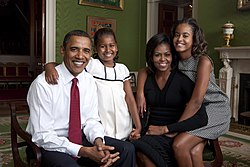


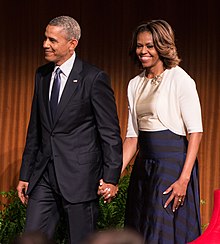
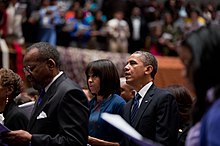

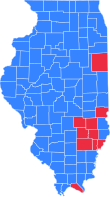





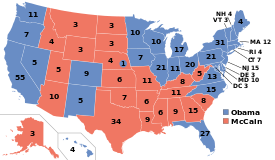


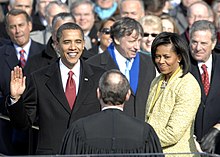
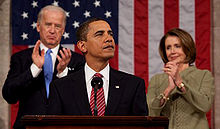
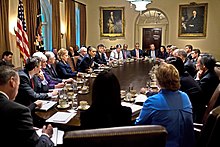

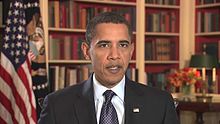


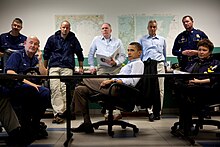
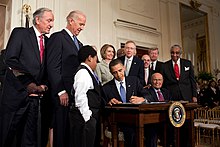




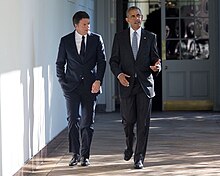



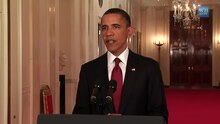
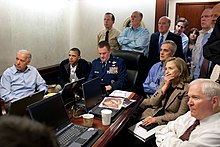
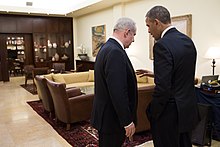








No comments:
Post a Comment